CNA347: Proposal: Improving Childhood Asthma Management Education
VerifiedAdded on 2022/08/26
|7
|2888
|23
Project
AI Summary
This assignment presents a proposal for an educational tool aimed at enhancing parental knowledge and awareness regarding childhood asthma management. The proposal identifies a significant educational gap concerning parental understanding of asthma symptoms, triggers, and medication administration, impacting children's health outcomes. The tool targets parents of children under 13 admitted to respiratory wards, offering a one-to-one teaching session with a multidisciplinary team. The session will utilize a PowerPoint presentation and printed resources to cover asthma pathophysiology, causative factors, screening tests, and medication strategies. Effectiveness will be evaluated using the Newcastle Asthma Knowledge Questionnaire and feedback sessions. Future recommendations suggest expanding the tool to include children. The proposal underscores the importance of parental education in improving asthma management and children's quality of life, supported by evidence-based research.
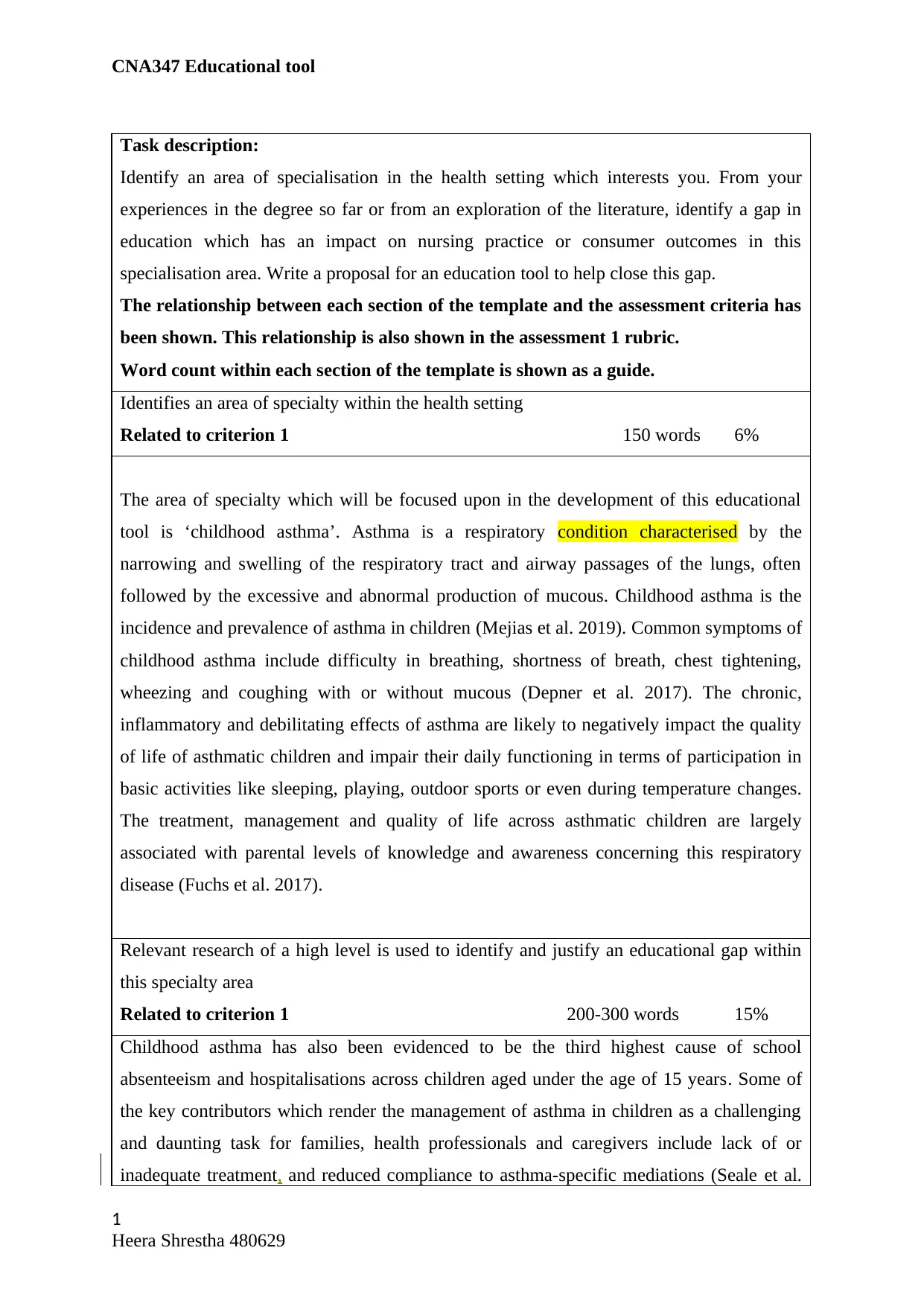
CNA347 Educational tool
Task description:
Identify an area of specialisation in the health setting which interests you. From your
experiences in the degree so far or from an exploration of the literature, identify a gap in
education which has an impact on nursing practice or consumer outcomes in this
specialisation area. Write a proposal for an education tool to help close this gap.
The relationship between each section of the template and the assessment criteria has
been shown. This relationship is also shown in the assessment 1 rubric.
Word count within each section of the template is shown as a guide.
Identifies an area of specialty within the health setting
Related to criterion 1 150 words 6%
The area of specialty which will be focused upon in the development of this educational
tool is ‘childhood asthma’. Asthma is a respiratory condition characterised by the
narrowing and swelling of the respiratory tract and airway passages of the lungs, often
followed by the excessive and abnormal production of mucous. Childhood asthma is the
incidence and prevalence of asthma in children (Mejias et al. 2019). Common symptoms of
childhood asthma include difficulty in breathing, shortness of breath, chest tightening,
wheezing and coughing with or without mucous (Depner et al. 2017). The chronic,
inflammatory and debilitating effects of asthma are likely to negatively impact the quality
of life of asthmatic children and impair their daily functioning in terms of participation in
basic activities like sleeping, playing, outdoor sports or even during temperature changes.
The treatment, management and quality of life across asthmatic children are largely
associated with parental levels of knowledge and awareness concerning this respiratory
disease (Fuchs et al. 2017).
Relevant research of a high level is used to identify and justify an educational gap within
this specialty area
Related to criterion 1 200-300 words 15%
Childhood asthma has also been evidenced to be the third highest cause of school
absenteeism and hospitalisations across children aged under the age of 15 years. Some of
the key contributors which render the management of asthma in children as a challenging
and daunting task for families, health professionals and caregivers include lack of or
inadequate treatment, and reduced compliance to asthma-specific mediations (Seale et al.
1
Heera Shrestha 480629
Task description:
Identify an area of specialisation in the health setting which interests you. From your
experiences in the degree so far or from an exploration of the literature, identify a gap in
education which has an impact on nursing practice or consumer outcomes in this
specialisation area. Write a proposal for an education tool to help close this gap.
The relationship between each section of the template and the assessment criteria has
been shown. This relationship is also shown in the assessment 1 rubric.
Word count within each section of the template is shown as a guide.
Identifies an area of specialty within the health setting
Related to criterion 1 150 words 6%
The area of specialty which will be focused upon in the development of this educational
tool is ‘childhood asthma’. Asthma is a respiratory condition characterised by the
narrowing and swelling of the respiratory tract and airway passages of the lungs, often
followed by the excessive and abnormal production of mucous. Childhood asthma is the
incidence and prevalence of asthma in children (Mejias et al. 2019). Common symptoms of
childhood asthma include difficulty in breathing, shortness of breath, chest tightening,
wheezing and coughing with or without mucous (Depner et al. 2017). The chronic,
inflammatory and debilitating effects of asthma are likely to negatively impact the quality
of life of asthmatic children and impair their daily functioning in terms of participation in
basic activities like sleeping, playing, outdoor sports or even during temperature changes.
The treatment, management and quality of life across asthmatic children are largely
associated with parental levels of knowledge and awareness concerning this respiratory
disease (Fuchs et al. 2017).
Relevant research of a high level is used to identify and justify an educational gap within
this specialty area
Related to criterion 1 200-300 words 15%
Childhood asthma has also been evidenced to be the third highest cause of school
absenteeism and hospitalisations across children aged under the age of 15 years. Some of
the key contributors which render the management of asthma in children as a challenging
and daunting task for families, health professionals and caregivers include lack of or
inadequate treatment, and reduced compliance to asthma-specific mediations (Seale et al.
1
Heera Shrestha 480629
Paraphrase This Document
Need a fresh take? Get an instant paraphrase of this document with our AI Paraphraser
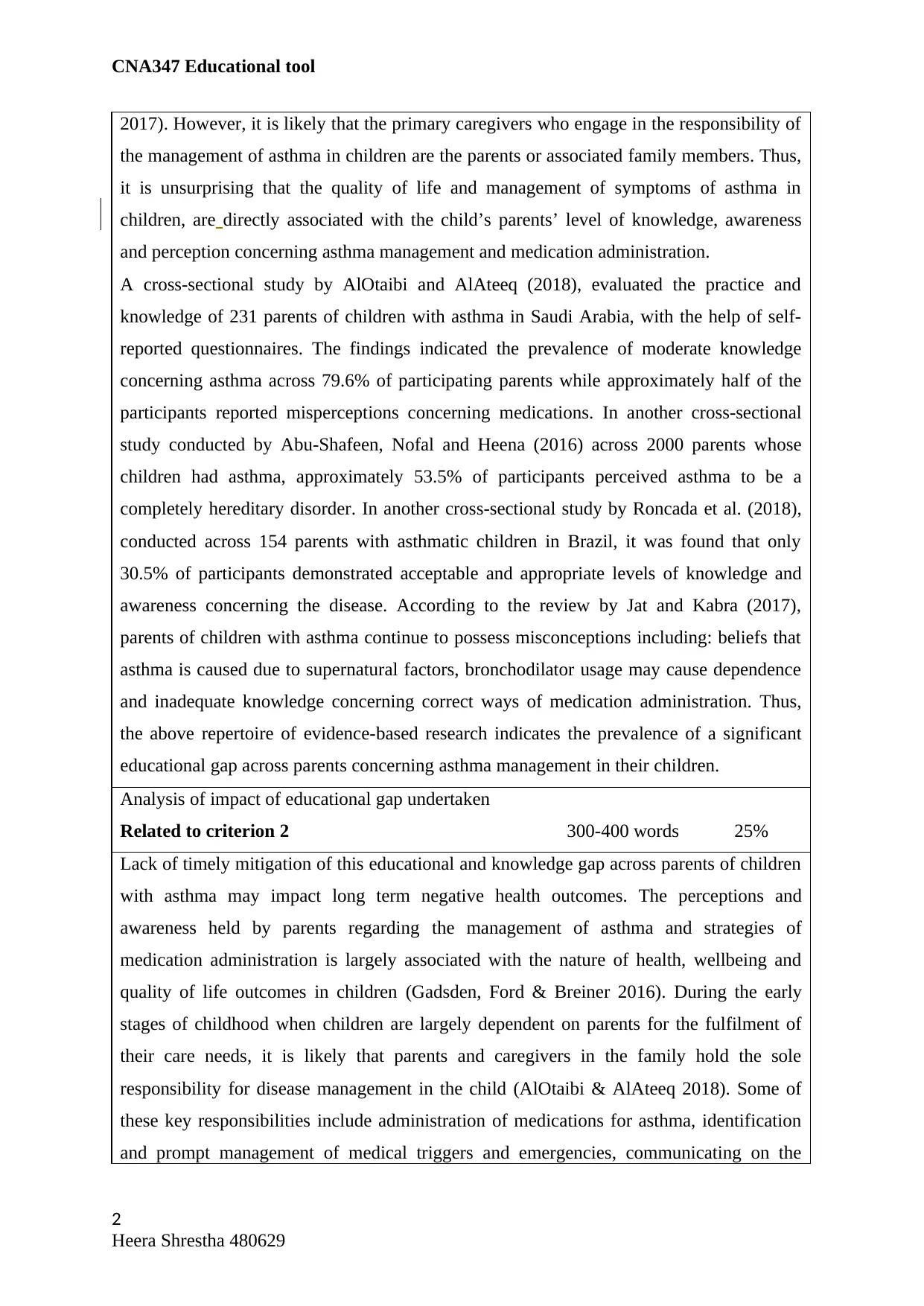
CNA347 Educational tool
2017). However, it is likely that the primary caregivers who engage in the responsibility of
the management of asthma in children are the parents or associated family members. Thus,
it is unsurprising that the quality of life and management of symptoms of asthma in
children, are directly associated with the child’s parents’ level of knowledge, awareness
and perception concerning asthma management and medication administration.
A cross-sectional study by AlOtaibi and AlAteeq (2018), evaluated the practice and
knowledge of 231 parents of children with asthma in Saudi Arabia, with the help of self-
reported questionnaires. The findings indicated the prevalence of moderate knowledge
concerning asthma across 79.6% of participating parents while approximately half of the
participants reported misperceptions concerning medications. In another cross-sectional
study conducted by Abu-Shafeen, Nofal and Heena (2016) across 2000 parents whose
children had asthma, approximately 53.5% of participants perceived asthma to be a
completely hereditary disorder. In another cross-sectional study by Roncada et al. (2018),
conducted across 154 parents with asthmatic children in Brazil, it was found that only
30.5% of participants demonstrated acceptable and appropriate levels of knowledge and
awareness concerning the disease. According to the review by Jat and Kabra (2017),
parents of children with asthma continue to possess misconceptions including: beliefs that
asthma is caused due to supernatural factors, bronchodilator usage may cause dependence
and inadequate knowledge concerning correct ways of medication administration. Thus,
the above repertoire of evidence-based research indicates the prevalence of a significant
educational gap across parents concerning asthma management in their children.
Analysis of impact of educational gap undertaken
Related to criterion 2 300-400 words 25%
Lack of timely mitigation of this educational and knowledge gap across parents of children
with asthma may impact long term negative health outcomes. The perceptions and
awareness held by parents regarding the management of asthma and strategies of
medication administration is largely associated with the nature of health, wellbeing and
quality of life outcomes in children (Gadsden, Ford & Breiner 2016). During the early
stages of childhood when children are largely dependent on parents for the fulfilment of
their care needs, it is likely that parents and caregivers in the family hold the sole
responsibility for disease management in the child (AlOtaibi & AlAteeq 2018). Some of
these key responsibilities include administration of medications for asthma, identification
and prompt management of medical triggers and emergencies, communicating on the
2
Heera Shrestha 480629
2017). However, it is likely that the primary caregivers who engage in the responsibility of
the management of asthma in children are the parents or associated family members. Thus,
it is unsurprising that the quality of life and management of symptoms of asthma in
children, are directly associated with the child’s parents’ level of knowledge, awareness
and perception concerning asthma management and medication administration.
A cross-sectional study by AlOtaibi and AlAteeq (2018), evaluated the practice and
knowledge of 231 parents of children with asthma in Saudi Arabia, with the help of self-
reported questionnaires. The findings indicated the prevalence of moderate knowledge
concerning asthma across 79.6% of participating parents while approximately half of the
participants reported misperceptions concerning medications. In another cross-sectional
study conducted by Abu-Shafeen, Nofal and Heena (2016) across 2000 parents whose
children had asthma, approximately 53.5% of participants perceived asthma to be a
completely hereditary disorder. In another cross-sectional study by Roncada et al. (2018),
conducted across 154 parents with asthmatic children in Brazil, it was found that only
30.5% of participants demonstrated acceptable and appropriate levels of knowledge and
awareness concerning the disease. According to the review by Jat and Kabra (2017),
parents of children with asthma continue to possess misconceptions including: beliefs that
asthma is caused due to supernatural factors, bronchodilator usage may cause dependence
and inadequate knowledge concerning correct ways of medication administration. Thus,
the above repertoire of evidence-based research indicates the prevalence of a significant
educational gap across parents concerning asthma management in their children.
Analysis of impact of educational gap undertaken
Related to criterion 2 300-400 words 25%
Lack of timely mitigation of this educational and knowledge gap across parents of children
with asthma may impact long term negative health outcomes. The perceptions and
awareness held by parents regarding the management of asthma and strategies of
medication administration is largely associated with the nature of health, wellbeing and
quality of life outcomes in children (Gadsden, Ford & Breiner 2016). During the early
stages of childhood when children are largely dependent on parents for the fulfilment of
their care needs, it is likely that parents and caregivers in the family hold the sole
responsibility for disease management in the child (AlOtaibi & AlAteeq 2018). Some of
these key responsibilities include administration of medications for asthma, identification
and prompt management of medical triggers and emergencies, communicating on the
2
Heera Shrestha 480629
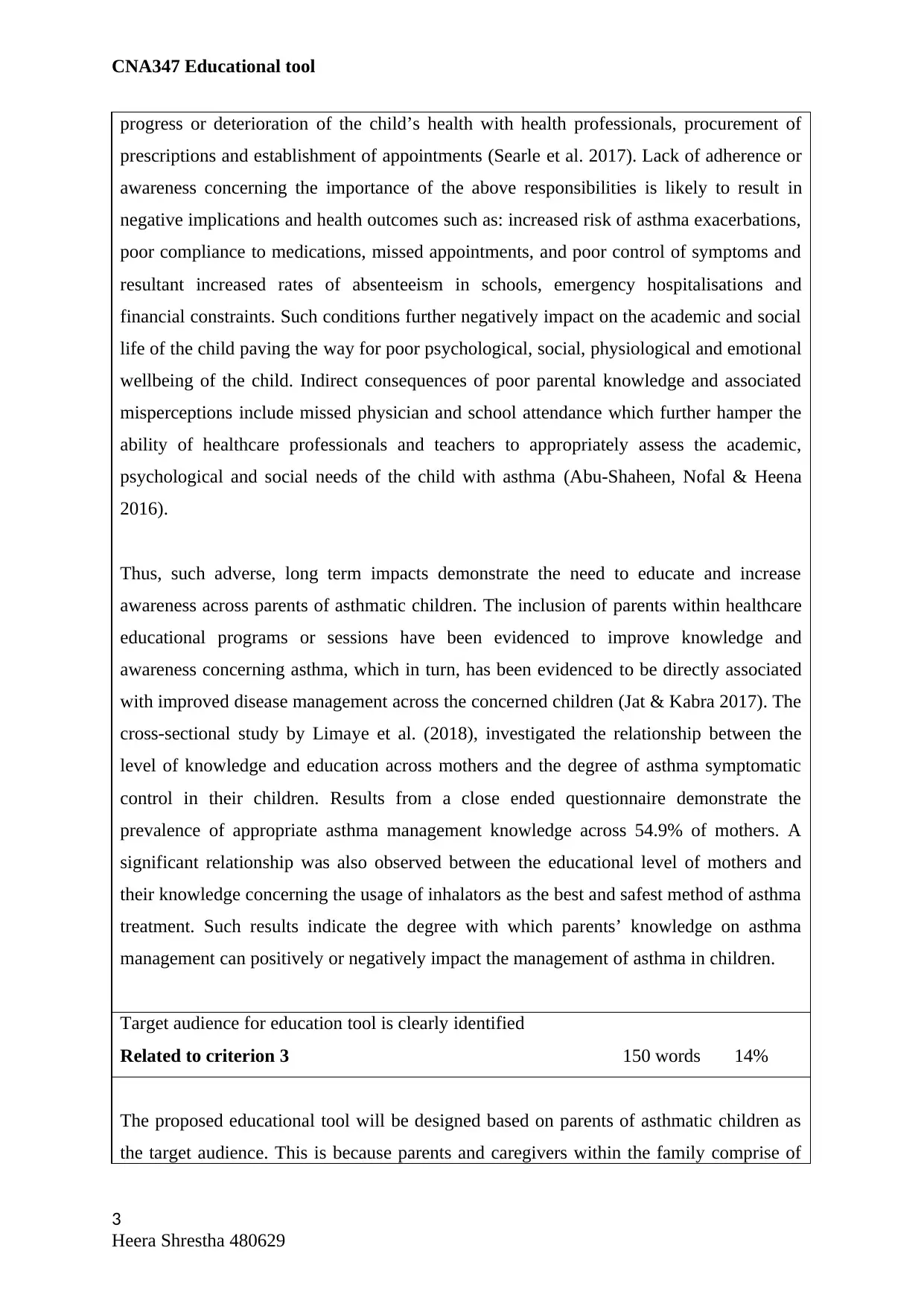
CNA347 Educational tool
progress or deterioration of the child’s health with health professionals, procurement of
prescriptions and establishment of appointments (Searle et al. 2017). Lack of adherence or
awareness concerning the importance of the above responsibilities is likely to result in
negative implications and health outcomes such as: increased risk of asthma exacerbations,
poor compliance to medications, missed appointments, and poor control of symptoms and
resultant increased rates of absenteeism in schools, emergency hospitalisations and
financial constraints. Such conditions further negatively impact on the academic and social
life of the child paving the way for poor psychological, social, physiological and emotional
wellbeing of the child. Indirect consequences of poor parental knowledge and associated
misperceptions include missed physician and school attendance which further hamper the
ability of healthcare professionals and teachers to appropriately assess the academic,
psychological and social needs of the child with asthma (Abu-Shaheen, Nofal & Heena
2016).
Thus, such adverse, long term impacts demonstrate the need to educate and increase
awareness across parents of asthmatic children. The inclusion of parents within healthcare
educational programs or sessions have been evidenced to improve knowledge and
awareness concerning asthma, which in turn, has been evidenced to be directly associated
with improved disease management across the concerned children (Jat & Kabra 2017). The
cross-sectional study by Limaye et al. (2018), investigated the relationship between the
level of knowledge and education across mothers and the degree of asthma symptomatic
control in their children. Results from a close ended questionnaire demonstrate the
prevalence of appropriate asthma management knowledge across 54.9% of mothers. A
significant relationship was also observed between the educational level of mothers and
their knowledge concerning the usage of inhalators as the best and safest method of asthma
treatment. Such results indicate the degree with which parents’ knowledge on asthma
management can positively or negatively impact the management of asthma in children.
Target audience for education tool is clearly identified
Related to criterion 3 150 words 14%
The proposed educational tool will be designed based on parents of asthmatic children as
the target audience. This is because parents and caregivers within the family comprise of
3
Heera Shrestha 480629
progress or deterioration of the child’s health with health professionals, procurement of
prescriptions and establishment of appointments (Searle et al. 2017). Lack of adherence or
awareness concerning the importance of the above responsibilities is likely to result in
negative implications and health outcomes such as: increased risk of asthma exacerbations,
poor compliance to medications, missed appointments, and poor control of symptoms and
resultant increased rates of absenteeism in schools, emergency hospitalisations and
financial constraints. Such conditions further negatively impact on the academic and social
life of the child paving the way for poor psychological, social, physiological and emotional
wellbeing of the child. Indirect consequences of poor parental knowledge and associated
misperceptions include missed physician and school attendance which further hamper the
ability of healthcare professionals and teachers to appropriately assess the academic,
psychological and social needs of the child with asthma (Abu-Shaheen, Nofal & Heena
2016).
Thus, such adverse, long term impacts demonstrate the need to educate and increase
awareness across parents of asthmatic children. The inclusion of parents within healthcare
educational programs or sessions have been evidenced to improve knowledge and
awareness concerning asthma, which in turn, has been evidenced to be directly associated
with improved disease management across the concerned children (Jat & Kabra 2017). The
cross-sectional study by Limaye et al. (2018), investigated the relationship between the
level of knowledge and education across mothers and the degree of asthma symptomatic
control in their children. Results from a close ended questionnaire demonstrate the
prevalence of appropriate asthma management knowledge across 54.9% of mothers. A
significant relationship was also observed between the educational level of mothers and
their knowledge concerning the usage of inhalators as the best and safest method of asthma
treatment. Such results indicate the degree with which parents’ knowledge on asthma
management can positively or negatively impact the management of asthma in children.
Target audience for education tool is clearly identified
Related to criterion 3 150 words 14%
The proposed educational tool will be designed based on parents of asthmatic children as
the target audience. This is because parents and caregivers within the family comprise of
3
Heera Shrestha 480629
⊘ This is a preview!⊘
Do you want full access?
Subscribe today to unlock all pages.

Trusted by 1+ million students worldwide
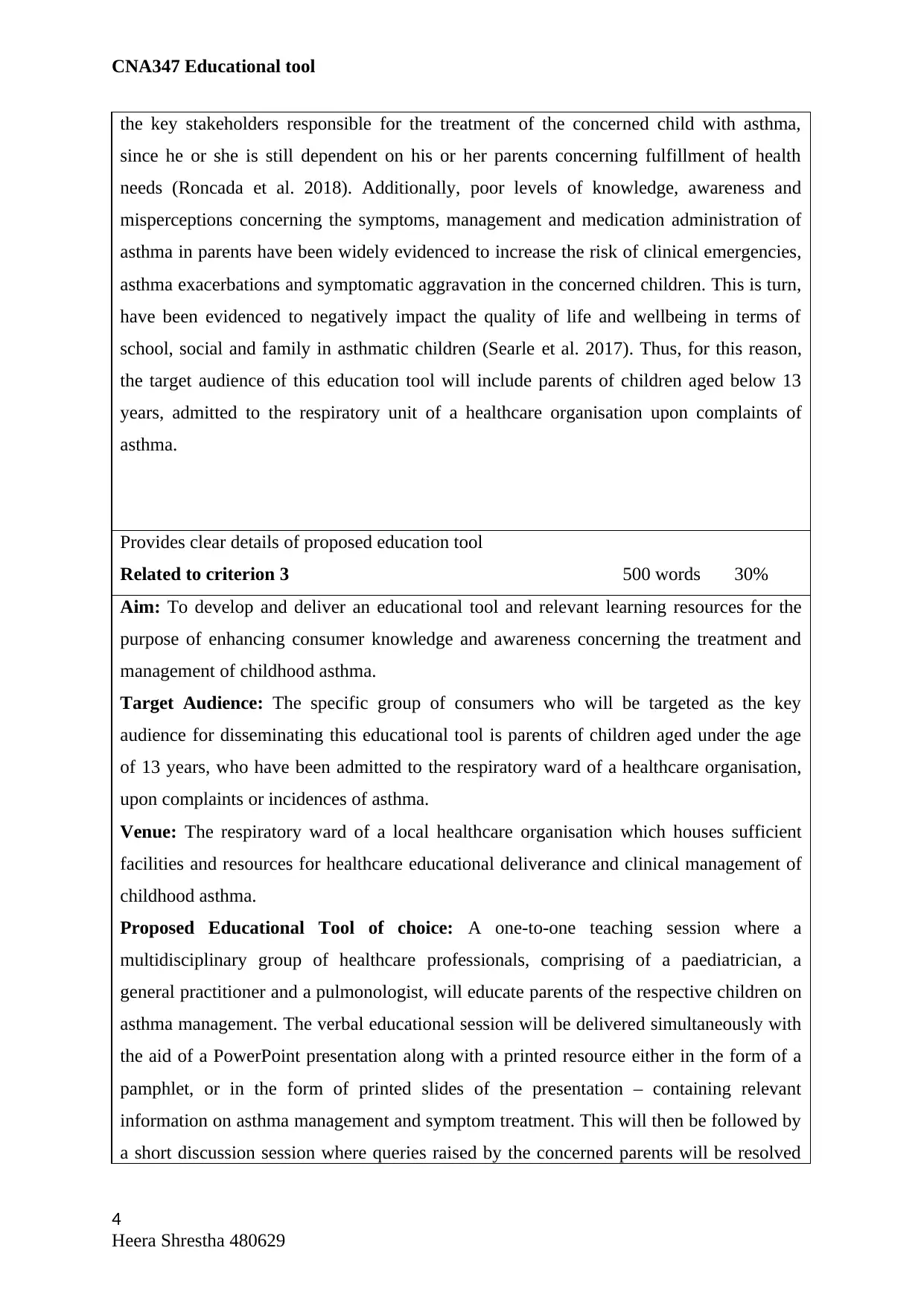
CNA347 Educational tool
the key stakeholders responsible for the treatment of the concerned child with asthma,
since he or she is still dependent on his or her parents concerning fulfillment of health
needs (Roncada et al. 2018). Additionally, poor levels of knowledge, awareness and
misperceptions concerning the symptoms, management and medication administration of
asthma in parents have been widely evidenced to increase the risk of clinical emergencies,
asthma exacerbations and symptomatic aggravation in the concerned children. This is turn,
have been evidenced to negatively impact the quality of life and wellbeing in terms of
school, social and family in asthmatic children (Searle et al. 2017). Thus, for this reason,
the target audience of this education tool will include parents of children aged below 13
years, admitted to the respiratory unit of a healthcare organisation upon complaints of
asthma.
Provides clear details of proposed education tool
Related to criterion 3 500 words 30%
Aim: To develop and deliver an educational tool and relevant learning resources for the
purpose of enhancing consumer knowledge and awareness concerning the treatment and
management of childhood asthma.
Target Audience: The specific group of consumers who will be targeted as the key
audience for disseminating this educational tool is parents of children aged under the age
of 13 years, who have been admitted to the respiratory ward of a healthcare organisation,
upon complaints or incidences of asthma.
Venue: The respiratory ward of a local healthcare organisation which houses sufficient
facilities and resources for healthcare educational deliverance and clinical management of
childhood asthma.
Proposed Educational Tool of choice: A one-to-one teaching session where a
multidisciplinary group of healthcare professionals, comprising of a paediatrician, a
general practitioner and a pulmonologist, will educate parents of the respective children on
asthma management. The verbal educational session will be delivered simultaneously with
the aid of a PowerPoint presentation along with a printed resource either in the form of a
pamphlet, or in the form of printed slides of the presentation – containing relevant
information on asthma management and symptom treatment. This will then be followed by
a short discussion session where queries raised by the concerned parents will be resolved
4
Heera Shrestha 480629
the key stakeholders responsible for the treatment of the concerned child with asthma,
since he or she is still dependent on his or her parents concerning fulfillment of health
needs (Roncada et al. 2018). Additionally, poor levels of knowledge, awareness and
misperceptions concerning the symptoms, management and medication administration of
asthma in parents have been widely evidenced to increase the risk of clinical emergencies,
asthma exacerbations and symptomatic aggravation in the concerned children. This is turn,
have been evidenced to negatively impact the quality of life and wellbeing in terms of
school, social and family in asthmatic children (Searle et al. 2017). Thus, for this reason,
the target audience of this education tool will include parents of children aged below 13
years, admitted to the respiratory unit of a healthcare organisation upon complaints of
asthma.
Provides clear details of proposed education tool
Related to criterion 3 500 words 30%
Aim: To develop and deliver an educational tool and relevant learning resources for the
purpose of enhancing consumer knowledge and awareness concerning the treatment and
management of childhood asthma.
Target Audience: The specific group of consumers who will be targeted as the key
audience for disseminating this educational tool is parents of children aged under the age
of 13 years, who have been admitted to the respiratory ward of a healthcare organisation,
upon complaints or incidences of asthma.
Venue: The respiratory ward of a local healthcare organisation which houses sufficient
facilities and resources for healthcare educational deliverance and clinical management of
childhood asthma.
Proposed Educational Tool of choice: A one-to-one teaching session where a
multidisciplinary group of healthcare professionals, comprising of a paediatrician, a
general practitioner and a pulmonologist, will educate parents of the respective children on
asthma management. The verbal educational session will be delivered simultaneously with
the aid of a PowerPoint presentation along with a printed resource either in the form of a
pamphlet, or in the form of printed slides of the presentation – containing relevant
information on asthma management and symptom treatment. This will then be followed by
a short discussion session where queries raised by the concerned parents will be resolved
4
Heera Shrestha 480629
Paraphrase This Document
Need a fresh take? Get an instant paraphrase of this document with our AI Paraphraser
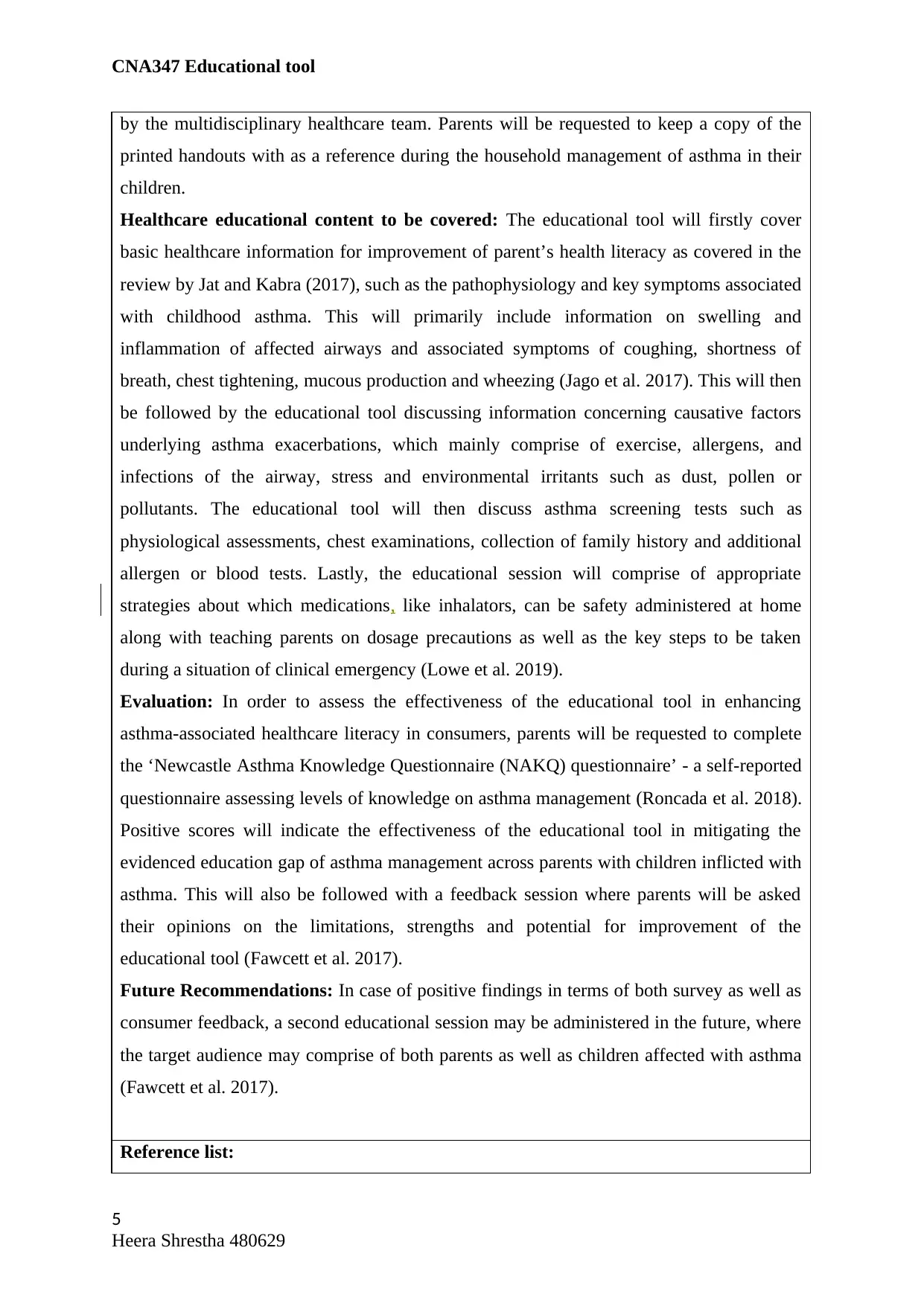
CNA347 Educational tool
by the multidisciplinary healthcare team. Parents will be requested to keep a copy of the
printed handouts with as a reference during the household management of asthma in their
children.
Healthcare educational content to be covered: The educational tool will firstly cover
basic healthcare information for improvement of parent’s health literacy as covered in the
review by Jat and Kabra (2017), such as the pathophysiology and key symptoms associated
with childhood asthma. This will primarily include information on swelling and
inflammation of affected airways and associated symptoms of coughing, shortness of
breath, chest tightening, mucous production and wheezing (Jago et al. 2017). This will then
be followed by the educational tool discussing information concerning causative factors
underlying asthma exacerbations, which mainly comprise of exercise, allergens, and
infections of the airway, stress and environmental irritants such as dust, pollen or
pollutants. The educational tool will then discuss asthma screening tests such as
physiological assessments, chest examinations, collection of family history and additional
allergen or blood tests. Lastly, the educational session will comprise of appropriate
strategies about which medications, like inhalators, can be safety administered at home
along with teaching parents on dosage precautions as well as the key steps to be taken
during a situation of clinical emergency (Lowe et al. 2019).
Evaluation: In order to assess the effectiveness of the educational tool in enhancing
asthma-associated healthcare literacy in consumers, parents will be requested to complete
the ‘Newcastle Asthma Knowledge Questionnaire (NAKQ) questionnaire’ - a self-reported
questionnaire assessing levels of knowledge on asthma management (Roncada et al. 2018).
Positive scores will indicate the effectiveness of the educational tool in mitigating the
evidenced education gap of asthma management across parents with children inflicted with
asthma. This will also be followed with a feedback session where parents will be asked
their opinions on the limitations, strengths and potential for improvement of the
educational tool (Fawcett et al. 2017).
Future Recommendations: In case of positive findings in terms of both survey as well as
consumer feedback, a second educational session may be administered in the future, where
the target audience may comprise of both parents as well as children affected with asthma
(Fawcett et al. 2017).
Reference list:
5
Heera Shrestha 480629
by the multidisciplinary healthcare team. Parents will be requested to keep a copy of the
printed handouts with as a reference during the household management of asthma in their
children.
Healthcare educational content to be covered: The educational tool will firstly cover
basic healthcare information for improvement of parent’s health literacy as covered in the
review by Jat and Kabra (2017), such as the pathophysiology and key symptoms associated
with childhood asthma. This will primarily include information on swelling and
inflammation of affected airways and associated symptoms of coughing, shortness of
breath, chest tightening, mucous production and wheezing (Jago et al. 2017). This will then
be followed by the educational tool discussing information concerning causative factors
underlying asthma exacerbations, which mainly comprise of exercise, allergens, and
infections of the airway, stress and environmental irritants such as dust, pollen or
pollutants. The educational tool will then discuss asthma screening tests such as
physiological assessments, chest examinations, collection of family history and additional
allergen or blood tests. Lastly, the educational session will comprise of appropriate
strategies about which medications, like inhalators, can be safety administered at home
along with teaching parents on dosage precautions as well as the key steps to be taken
during a situation of clinical emergency (Lowe et al. 2019).
Evaluation: In order to assess the effectiveness of the educational tool in enhancing
asthma-associated healthcare literacy in consumers, parents will be requested to complete
the ‘Newcastle Asthma Knowledge Questionnaire (NAKQ) questionnaire’ - a self-reported
questionnaire assessing levels of knowledge on asthma management (Roncada et al. 2018).
Positive scores will indicate the effectiveness of the educational tool in mitigating the
evidenced education gap of asthma management across parents with children inflicted with
asthma. This will also be followed with a feedback session where parents will be asked
their opinions on the limitations, strengths and potential for improvement of the
educational tool (Fawcett et al. 2017).
Future Recommendations: In case of positive findings in terms of both survey as well as
consumer feedback, a second educational session may be administered in the future, where
the target audience may comprise of both parents as well as children affected with asthma
(Fawcett et al. 2017).
Reference list:
5
Heera Shrestha 480629
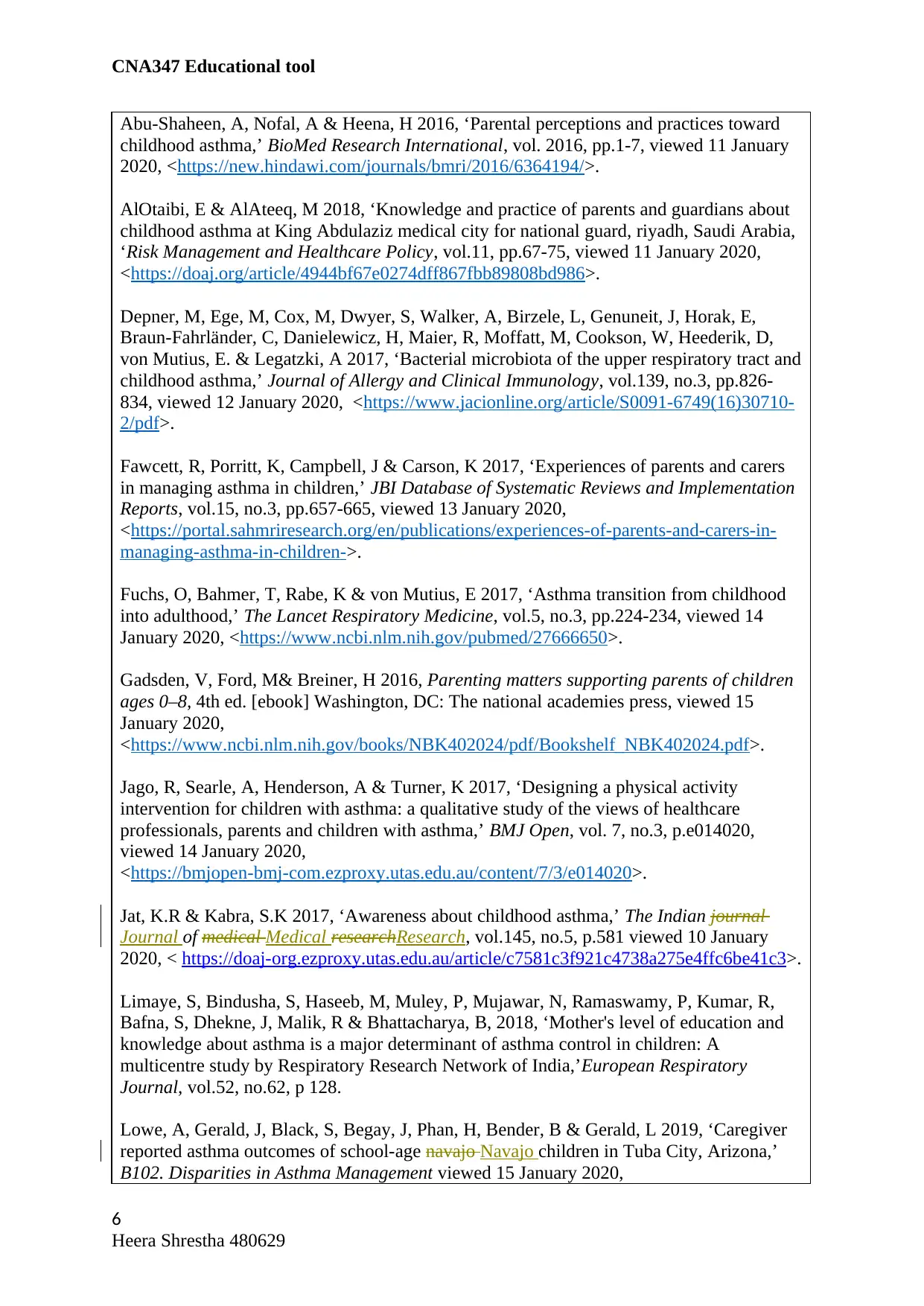
CNA347 Educational tool
Abu-Shaheen, A, Nofal, A & Heena, H 2016, ‘Parental perceptions and practices toward
childhood asthma,’ BioMed Research International, vol. 2016, pp.1-7, viewed 11 January
2020, <https://new.hindawi.com/journals/bmri/2016/6364194/>.
AlOtaibi, E & AlAteeq, M 2018, ‘Knowledge and practice of parents and guardians about
childhood asthma at King Abdulaziz medical city for national guard, riyadh, Saudi Arabia,
‘Risk Management and Healthcare Policy, vol.11, pp.67-75, viewed 11 January 2020,
<https://doaj.org/article/4944bf67e0274dff867fbb89808bd986>.
Depner, M, Ege, M, Cox, M, Dwyer, S, Walker, A, Birzele, L, Genuneit, J, Horak, E,
Braun-Fahrländer, C, Danielewicz, H, Maier, R, Moffatt, M, Cookson, W, Heederik, D,
von Mutius, E. & Legatzki, A 2017, ‘Bacterial microbiota of the upper respiratory tract and
childhood asthma,’ Journal of Allergy and Clinical Immunology, vol.139, no.3, pp.826-
834, viewed 12 January 2020, <https://www.jacionline.org/article/S0091-6749(16)30710-
2/pdf>.
Fawcett, R, Porritt, K, Campbell, J & Carson, K 2017, ‘Experiences of parents and carers
in managing asthma in children,’ JBI Database of Systematic Reviews and Implementation
Reports, vol.15, no.3, pp.657-665, viewed 13 January 2020,
<https://portal.sahmriresearch.org/en/publications/experiences-of-parents-and-carers-in-
managing-asthma-in-children->.
Fuchs, O, Bahmer, T, Rabe, K & von Mutius, E 2017, ‘Asthma transition from childhood
into adulthood,’ The Lancet Respiratory Medicine, vol.5, no.3, pp.224-234, viewed 14
January 2020, <https://www.ncbi.nlm.nih.gov/pubmed/27666650>.
Gadsden, V, Ford, M& Breiner, H 2016, Parenting matters supporting parents of children
ages 0–8, 4th ed. [ebook] Washington, DC: The national academies press, viewed 15
January 2020,
<https://www.ncbi.nlm.nih.gov/books/NBK402024/pdf/Bookshelf_NBK402024.pdf>.
Jago, R, Searle, A, Henderson, A & Turner, K 2017, ‘Designing a physical activity
intervention for children with asthma: a qualitative study of the views of healthcare
professionals, parents and children with asthma,’ BMJ Open, vol. 7, no.3, p.e014020,
viewed 14 January 2020,
<https://bmjopen-bmj-com.ezproxy.utas.edu.au/content/7/3/e014020>.
Jat, K.R & Kabra, S.K 2017, ‘Awareness about childhood asthma,’ The Indian journal
Journal of medical Medical researchResearch, vol.145, no.5, p.581 viewed 10 January
2020, < https://doaj-org.ezproxy.utas.edu.au/article/c7581c3f921c4738a275e4ffc6be41c3>.
Limaye, S, Bindusha, S, Haseeb, M, Muley, P, Mujawar, N, Ramaswamy, P, Kumar, R,
Bafna, S, Dhekne, J, Malik, R & Bhattacharya, B, 2018, ‘Mother's level of education and
knowledge about asthma is a major determinant of asthma control in children: A
multicentre study by Respiratory Research Network of India,’European Respiratory
Journal, vol.52, no.62, p 128.
Lowe, A, Gerald, J, Black, S, Begay, J, Phan, H, Bender, B & Gerald, L 2019, ‘Caregiver
reported asthma outcomes of school-age navajo Navajo children in Tuba City, Arizona,’
B102. Disparities in Asthma Management viewed 15 January 2020,
6
Heera Shrestha 480629
Abu-Shaheen, A, Nofal, A & Heena, H 2016, ‘Parental perceptions and practices toward
childhood asthma,’ BioMed Research International, vol. 2016, pp.1-7, viewed 11 January
2020, <https://new.hindawi.com/journals/bmri/2016/6364194/>.
AlOtaibi, E & AlAteeq, M 2018, ‘Knowledge and practice of parents and guardians about
childhood asthma at King Abdulaziz medical city for national guard, riyadh, Saudi Arabia,
‘Risk Management and Healthcare Policy, vol.11, pp.67-75, viewed 11 January 2020,
<https://doaj.org/article/4944bf67e0274dff867fbb89808bd986>.
Depner, M, Ege, M, Cox, M, Dwyer, S, Walker, A, Birzele, L, Genuneit, J, Horak, E,
Braun-Fahrländer, C, Danielewicz, H, Maier, R, Moffatt, M, Cookson, W, Heederik, D,
von Mutius, E. & Legatzki, A 2017, ‘Bacterial microbiota of the upper respiratory tract and
childhood asthma,’ Journal of Allergy and Clinical Immunology, vol.139, no.3, pp.826-
834, viewed 12 January 2020, <https://www.jacionline.org/article/S0091-6749(16)30710-
2/pdf>.
Fawcett, R, Porritt, K, Campbell, J & Carson, K 2017, ‘Experiences of parents and carers
in managing asthma in children,’ JBI Database of Systematic Reviews and Implementation
Reports, vol.15, no.3, pp.657-665, viewed 13 January 2020,
<https://portal.sahmriresearch.org/en/publications/experiences-of-parents-and-carers-in-
managing-asthma-in-children->.
Fuchs, O, Bahmer, T, Rabe, K & von Mutius, E 2017, ‘Asthma transition from childhood
into adulthood,’ The Lancet Respiratory Medicine, vol.5, no.3, pp.224-234, viewed 14
January 2020, <https://www.ncbi.nlm.nih.gov/pubmed/27666650>.
Gadsden, V, Ford, M& Breiner, H 2016, Parenting matters supporting parents of children
ages 0–8, 4th ed. [ebook] Washington, DC: The national academies press, viewed 15
January 2020,
<https://www.ncbi.nlm.nih.gov/books/NBK402024/pdf/Bookshelf_NBK402024.pdf>.
Jago, R, Searle, A, Henderson, A & Turner, K 2017, ‘Designing a physical activity
intervention for children with asthma: a qualitative study of the views of healthcare
professionals, parents and children with asthma,’ BMJ Open, vol. 7, no.3, p.e014020,
viewed 14 January 2020,
<https://bmjopen-bmj-com.ezproxy.utas.edu.au/content/7/3/e014020>.
Jat, K.R & Kabra, S.K 2017, ‘Awareness about childhood asthma,’ The Indian journal
Journal of medical Medical researchResearch, vol.145, no.5, p.581 viewed 10 January
2020, < https://doaj-org.ezproxy.utas.edu.au/article/c7581c3f921c4738a275e4ffc6be41c3>.
Limaye, S, Bindusha, S, Haseeb, M, Muley, P, Mujawar, N, Ramaswamy, P, Kumar, R,
Bafna, S, Dhekne, J, Malik, R & Bhattacharya, B, 2018, ‘Mother's level of education and
knowledge about asthma is a major determinant of asthma control in children: A
multicentre study by Respiratory Research Network of India,’European Respiratory
Journal, vol.52, no.62, p 128.
Lowe, A, Gerald, J, Black, S, Begay, J, Phan, H, Bender, B & Gerald, L 2019, ‘Caregiver
reported asthma outcomes of school-age navajo Navajo children in Tuba City, Arizona,’
B102. Disparities in Asthma Management viewed 15 January 2020,
6
Heera Shrestha 480629
⊘ This is a preview!⊘
Do you want full access?
Subscribe today to unlock all pages.

Trusted by 1+ million students worldwide
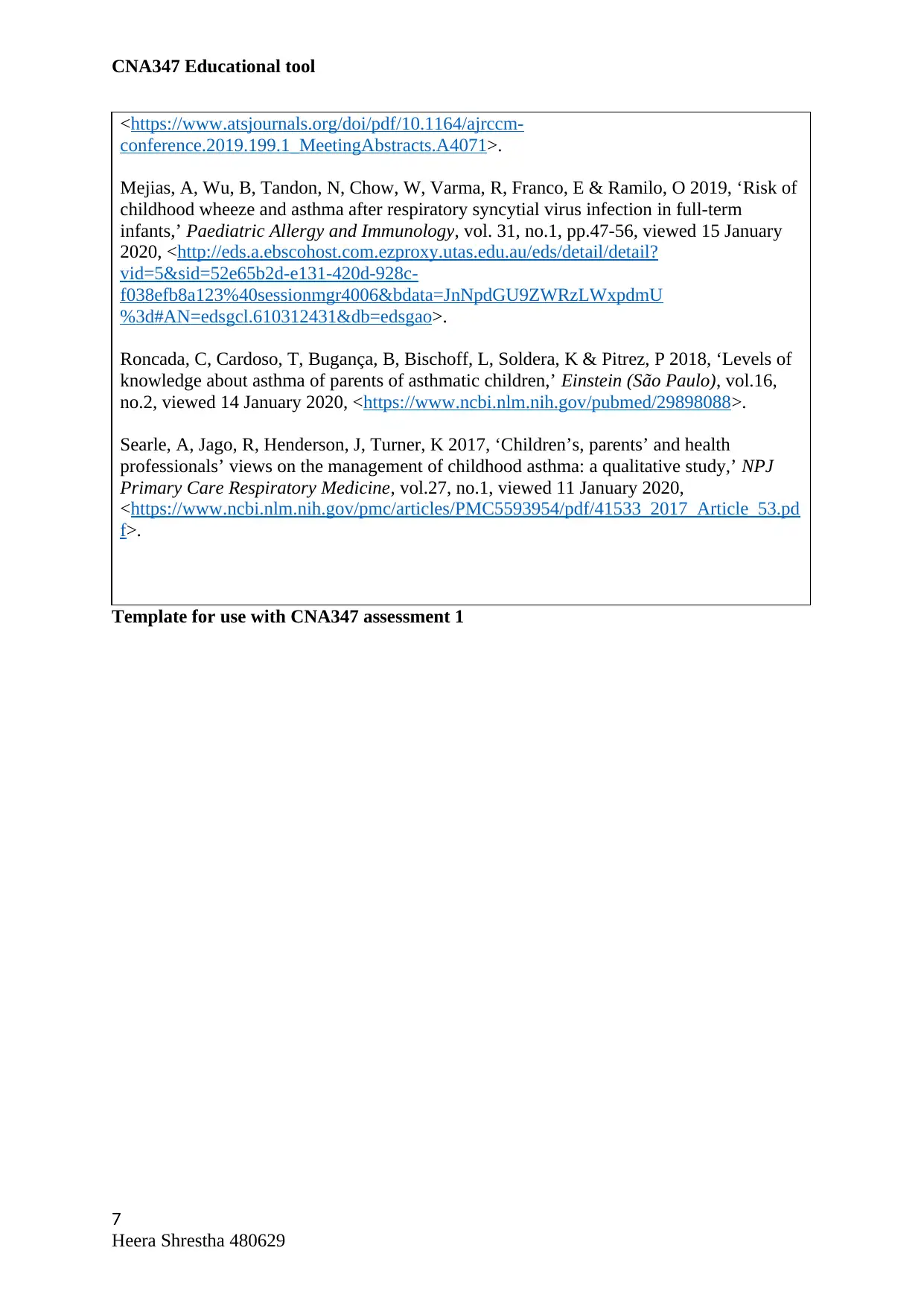
CNA347 Educational tool
<https://www.atsjournals.org/doi/pdf/10.1164/ajrccm-
conference.2019.199.1_MeetingAbstracts.A4071>.
Mejias, A, Wu, B, Tandon, N, Chow, W, Varma, R, Franco, E & Ramilo, O 2019, ‘Risk of
childhood wheeze and asthma after respiratory syncytial virus infection in full‐term
infants,’ Paediatric Allergy and Immunology, vol. 31, no.1, pp.47-56, viewed 15 January
2020, <http://eds.a.ebscohost.com.ezproxy.utas.edu.au/eds/detail/detail?
vid=5&sid=52e65b2d-e131-420d-928c-
f038efb8a123%40sessionmgr4006&bdata=JnNpdGU9ZWRzLWxpdmU
%3d#AN=edsgcl.610312431&db=edsgao>.
Roncada, C, Cardoso, T, Bugança, B, Bischoff, L, Soldera, K & Pitrez, P 2018, ‘Levels of
knowledge about asthma of parents of asthmatic children,’ Einstein (São Paulo), vol.16,
no.2, viewed 14 January 2020, <https://www.ncbi.nlm.nih.gov/pubmed/29898088>.
Searle, A, Jago, R, Henderson, J, Turner, K 2017, ‘Children’s, parents’ and health
professionals’ views on the management of childhood asthma: a qualitative study,’ NPJ
Primary Care Respiratory Medicine, vol.27, no.1, viewed 11 January 2020,
<https://www.ncbi.nlm.nih.gov/pmc/articles/PMC5593954/pdf/41533_2017_Article_53.pd
f>.
Template for use with CNA347 assessment 1
7
Heera Shrestha 480629
<https://www.atsjournals.org/doi/pdf/10.1164/ajrccm-
conference.2019.199.1_MeetingAbstracts.A4071>.
Mejias, A, Wu, B, Tandon, N, Chow, W, Varma, R, Franco, E & Ramilo, O 2019, ‘Risk of
childhood wheeze and asthma after respiratory syncytial virus infection in full‐term
infants,’ Paediatric Allergy and Immunology, vol. 31, no.1, pp.47-56, viewed 15 January
2020, <http://eds.a.ebscohost.com.ezproxy.utas.edu.au/eds/detail/detail?
vid=5&sid=52e65b2d-e131-420d-928c-
f038efb8a123%40sessionmgr4006&bdata=JnNpdGU9ZWRzLWxpdmU
%3d#AN=edsgcl.610312431&db=edsgao>.
Roncada, C, Cardoso, T, Bugança, B, Bischoff, L, Soldera, K & Pitrez, P 2018, ‘Levels of
knowledge about asthma of parents of asthmatic children,’ Einstein (São Paulo), vol.16,
no.2, viewed 14 January 2020, <https://www.ncbi.nlm.nih.gov/pubmed/29898088>.
Searle, A, Jago, R, Henderson, J, Turner, K 2017, ‘Children’s, parents’ and health
professionals’ views on the management of childhood asthma: a qualitative study,’ NPJ
Primary Care Respiratory Medicine, vol.27, no.1, viewed 11 January 2020,
<https://www.ncbi.nlm.nih.gov/pmc/articles/PMC5593954/pdf/41533_2017_Article_53.pd
f>.
Template for use with CNA347 assessment 1
7
Heera Shrestha 480629
1 out of 7
Your All-in-One AI-Powered Toolkit for Academic Success.
+13062052269
info@desklib.com
Available 24*7 on WhatsApp / Email
![[object Object]](/_next/static/media/star-bottom.7253800d.svg)
Unlock your academic potential
Copyright © 2020–2025 A2Z Services. All Rights Reserved. Developed and managed by ZUCOL.
